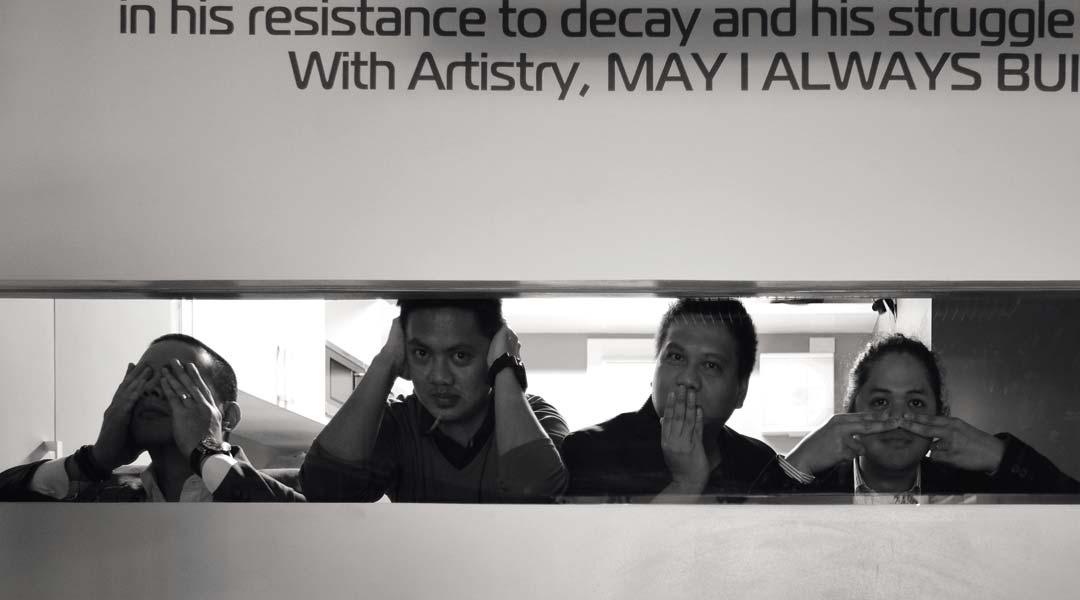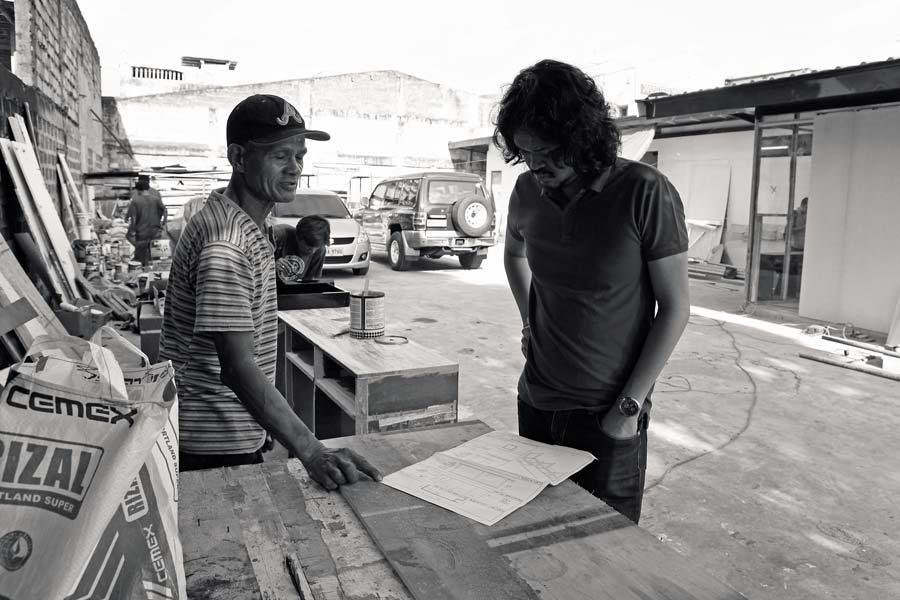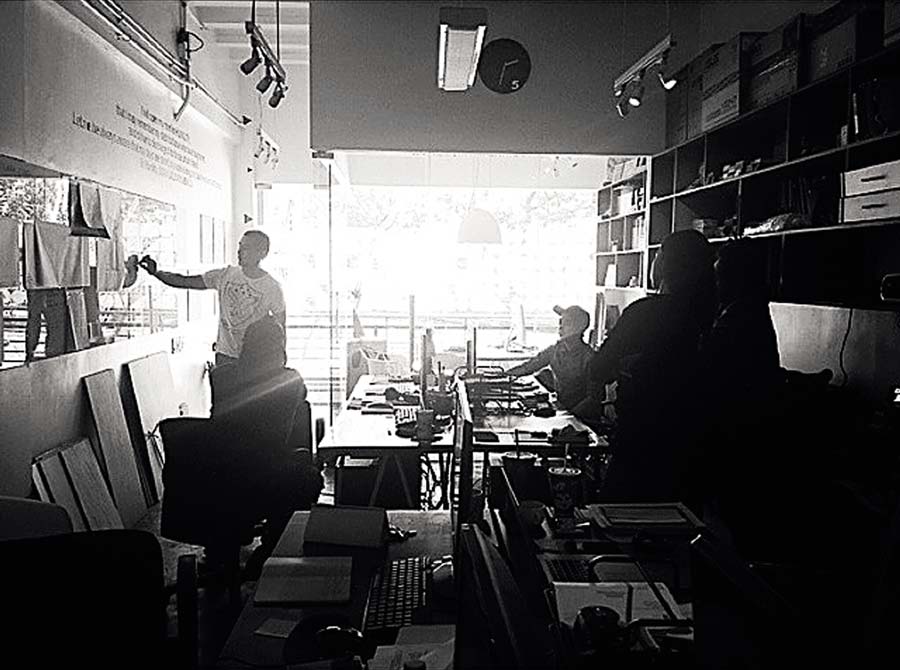
Learning from mistakes: Arkisens and 6×6 Builders
Chok Manalo, Eds Rivera, Jay Pacia and Tats Perez are the founding partners of Arkisens and 6×6 Builders. Architecture graduates from the University of Santo Tomas, they formed Arkisens in 2005 and 6×6 Builders in 2011. They offer architectural design and construction management services and have designed numerous residential and commercial projects within Metro Manila. Miguel Llona interviewed the partners to find out how vital it was that they learned from their mistakes early on in their careers.
Why did the four of you decide to start your own firm?
Chok Manalo: We were all friends in UST, but drifted apart after graduating in 2002. I was working for Joey Yupangco, while the others were busy working for other firms. In 2005, we all met again at WorldBex. We got to talking about starting our own firm, so we could be free to create and explore our own designs.
Jay Pacia: We said: “If we have the same goals, why not start our own company?” Na-excite kami—the thought of working with friends and having freedom over your own designs was very appealing.
Eds Rivera: We were confident we would work well as a team. We all had something different to offer because of our work experiences—Chok was trained in conceptual architecture by Yupangco, Jay’s forte was offices and construction, and Tats [Perez] learned about total design under BUDJI+ROYAL. The thing is, none of us had business backgrounds or architects for family members to teach us about the business side. Basta sabi namin, “Game!” It wasn’t a calculated risk—it was just a risk on our part [laughs]. But we didn’t think of it as a risk then. We were around 24 and 25 years old. Once we started, that was when we realized how intense the responsibility was that we were going to have to learn along the way.
What difficulties did you face?
Pacia: When we formed Arkisens, Eds, Tats and I were still working for other firms, so balancing our schedules was the first challenge. We didn’t force each other to resign from the firms we were working at—iniisip namin nun, kung kaya naman isabay within the framework of our existing jobs, sige. Pero hindi siya ideal [laughs]. My bosses got angry with me because I wasn’t finishing deliverables on time. The added workload from Arkisens affected my performance.
Manalo: Eds’ office was based in Baguio, so it was even more difficult. But we didn’t meet regularly because we weren’t juggling many projects anyway. That first year, we didn’t have a formal office, so we met in coffee shops or in each other’s houses. This didn’t bother us because that’s how we worked together in college [laughs].
Rivera: We didn’t have capital, or even a business plan. Our fees from our first projects served as our capital, kaya sobrang conscious namin sa gastos. We’d only spend when the need arose and when we had the money to spend. Have we saved enough money to rent an office? Then game, let’s rent a space. Can we afford a printer now? Then let’s buy one. Laging ganun, paunti-unti.
Where was your first office?
Manalo: Eds’ brother-in-law owned a printing company on Pasig Boulevard, whose office we occupied when they transferred. Working conditions were bad—walang aircon, walang phone, walang Internet. When we wanted to send an email, we had to buy a prepaid card from 7/11. We stayed there for one year, then we moved to BGC in 2006. My father-in-law had a unit in a residential compound he wanted to rent out, so we thought, why not use it as an office? So we transferred and stayed there from 2006 to 2012.
Rivera: We moved to a bigger space in Libis after, but our people kept increasing in number so we had to move out again. And we wanted to have space to put all our materials in, since by this time we already established 6×6 Builders, our construction company. Jay found this 700-square meter Marikina lot in 2015, where we’ve built our office, warehouse and workshop.

How did you find work and what projects did you take on?
Manalo: The first was an office renovation. Sobrang binu-bully kami nung client kasi bata kami [laughs]. He kept telling us to lessen our design fee, which was already small! Sabi pa niya, “Kung may pera kami, e di sana mas experienced architect nalang kinuha namin!” We tried to stand our ground but there was only so much we could do, because we didn’t have many accomplishments yet.
Rivera: We delivered more than what we billed clients for. We went out of our way to draft complete, signed and sealed drawings for every project. Kumpleto, lahat ng sulok may perspective! We wanted to give the impression we were more than capable of producing designs and plans worthy of veteran architects.
Manalo: Our mindset was to impress the client. We exerted too much effort; we were very aggressive. We drafted plans and sketches even before proposing a design fee. The process was important to us—the least we could do was show them the possibilities of the project through our designs. The downside was our efforts would go to waste when clients decided against hiring us, since there was no binding contract yet. Pero sige lang kami!
Rivera: There was a time we were asked to design a restaurant—we did an ocular of the site and drafted the presentation drawings before doing the design fee proposal. So when we finally presented it to the client, he said, “Drawing lang, ganito kamahal?” The project didn’t push through. We never let that discourage us, we just charged it to experience. We treated it like practice, kasi kailan ka pa makakapag-design uli ng ganun. And even if the design wasn’t approved, it was okay because it built up our portfolio. We still showed our unbuilt designs to prospective clients so they could see what we were capable of, which was important for us in terms of getting work.
Manalo: Having a website was a big help because it showcased our designs. We set one up two years after we formed when we had a residential project, an office, a commercial building and other typologies completed. Our first idea was to make it look like a comic strip, so we could tell the story of the firm through the work we were producing. One client told us that our business card (a red one) stood out from his pile of cards, which led to him checking out our website. He liked what he saw, so he commissioned us to design his house.
Why did you establish your own construction company, 6×6 Builders?
Manalo: Most of our early projects were design and build—we went beyond the design phase and handled the construction of our projects as well. For example, I’ll come up with a design, then once client approves it, I’ll mobilize the construction people in the site. I’ll go to the hardware to order materials, then I’ll deliver those to the site as well. I’ll give them their salaries every Friday. We were basically architect-contractors, so we decided to formalize the construction part of the business by establishing 6×6 Builders in 2011.
Pacia: It’s registered as a corporation, but we kept Arkisens as a partnership. This way, we can present ourselves formally as architects and contractors to corporate clients. And there was an assignment of responsibilities between the four of us: Eds and Chok manage Arkisens, while Tats and I handle 6×6.

What traits and skills do you look for when hiring people?
Manalo: When we receive portfolios, we check if they’re proficient with the basics, and if we have the same wavelength when it comes to design. When an applicant shows a penchant for traditional architecture, we won’t invite him for an interview anymore. If the work is conceptual, we call them for an interview, but we won’t talk about their work—we’ll just have a friendly chat to get to know their personality.
Pacia: That’s the real purpose of the interview. Applicants have to know the type of culture and atmosphere they’re getting into.
Rivera: We even ask them to write an essay about anything they want, so we’ll know what they’re passionate about. We have to know the person and how they interact with others because we need them to be able to talk to all kinds of people, from clients, consultants, even workers at the site. Even if you’re good in design, it won’t matter if you can’t communicate properly with other people. That’s what we went through eh—when we started out, we were our own drivers, purchasers, and foremen, so it was hands-on experience talaga. That’s what we want our staff to go through as well.
We delivered more than what we billed clients for. We went out of our way to draft complete drawings for every project.—Eds Rivera
Advice for young architects wanting to start their own firm?
Rivera: Mine is simple: Just do it. You’re the only one who can tell if you’re ready to set up a firm. It would be better if you have a business plan.
Manalo: It would help if you have financial backing. We started our own without one and we were really young, but it was our passion for design that carried us and continues to carry us to this day. So start your own, do it, but make sure you’re really passionate about it. When you’re operating your own firm, it involves long hours, and it won’t pay well at the start. And we were told that you won’t really enjoy the financial returns of your firm until after you’re 40…we’re still a few years away from that, so we’ll see if that’s true [laughs]. ![]()
This article was first published in BluPrint’s The Business of Design (Part I) special issue in May 2016.


